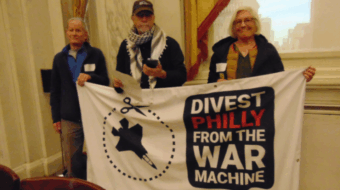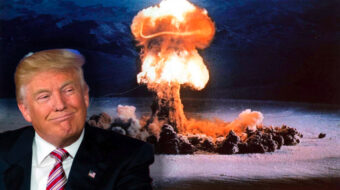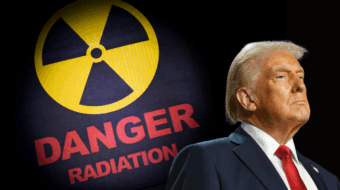
A major milestone on the long road to ridding the world entirely of nuclear weapons was reached on Jan. 22, as the United Nations Treaty on the Prohibition of Nuclear Weapons officially became part of international law.
That road began Jan. 24, 1946, when the newly formed United Nations adopted its very first resolution, just months after the U.S. atomic bombing of Hiroshima and Nagasaki in the final days of World War II. Resolution 1(1), which the General Assembly adopted by consensus, established a commission of the UN Security Council to ensure “the elimination from national armaments of atomic weapons and all other major weapons adaptable to mass destruction.”
And among those celebrating the latest step toward their abolition was one who knows from personal experience the catastrophic horrors that even the bombs of 75 years ago – crude and primitive by today’s standards – wreaked on those who experienced their impact.
Setsuko Thurow – then Setsuko Nakamura – was just 13 when the U.S. bombed Hiroshima. Knocked unconscious and pinned beneath a building by the blast, as she regained consciousness she was rescued after a soldier urged her to crawl toward sunlight. Though her parents also survived, she lost a sister and a nephew in the blast, which totally devastated the city. It is estimated that by the end of 1945, as many as 140,000 of the city’s 255,000 people had died as a result of the bombing. Far more were added to that list in the decades that followed.
Thurow, now 88, has lived in Canada for many decades and has dedicated her life to the fight for total abolition of nuclear arms.
“I simply can’t find the right words to express my thoughts,” she told Beatrice Fihn, executive director of the International Campaign to Abolish Nuclear Weapons – the lead organization in the campaign for the treaty, during ICAN’s global virtual celebration on Jan. 22.
“I am so overjoyed, and at the same time I’m most grateful to all those people who have worked with us … And I always remember at a time like this, whenever we have special moments of victory, or accomplishment, the hundreds of thousands of people in Hiroshima and Nagasaki who lost their lives. They paid so much for this, and we made the vow that this would not be in vain … And I think that significant time has come. I intend to continue this until we reach the final goal, the total elimination of nuclear weapons.”
The Treaty on the Prohibition of Nuclear Weapons, adopted in 2017 by 122 of the UN General Assembly’s then-192 member countries, bars states party to it from developing, testing, producing, manufacturing, transferring, possessing, stockpiling, using, or threatening to use nuclear weapons, or letting them be stationed on their territory, or helping, encouraging or pressing anyone to do so.
It also obligates states-parties to help the victims of nuclear weapons activities and clean up resulting damage.
To date, 86 countries have formally signed the TPNW – also known as “the Ban Treaty.” To date, 52 countries have ratified the treaty, and dozens more ratifications are expected, though so far no countries currently possessing nuclear weapons have joined in. In fact, as the all-important 50th ratification letting the treaty go into effect approached last October, the Associated Press revealed the U.S. had written to nations that had already ratified the document, urging them to rescind their action. None have done so.
For its leadership in the campaign, ICAN was awarded the Nobel Peace Prize in 2017.
In addition to ICAN’s virtual event, the campaign said over 170 celebrations were held around the world, in nuclear-armed and non-nuclear-armed nations. Among the many celebrations and calls for the U.S. to join the treaty were actions at U.S. nuclear weapons-related facilities, including the Pentagon, nuclear labs at Oak Ridge, Los Alamos, and Livermore, ballistic missile submarine bases in Washington State, universities participating in nuclear weapon research, and banks and investment firms that engage with the nuclear weapons industry.
At Lawrence Livermore National Laboratory, in the San Francisco Bay Area, Marylia Kelley, executive director of the watchdog organization Tri-Valley Communities Against a Radioactive Environment (Tri-Valley CAREs), was joined early in the morning by dozens of socially distanced participants displaying banners proclaiming, “Nuclear Weapons are Illegal,” to lab workers as they drove through the main gate.
Kelley reminded participants that Tri-Valley CAREs was one of some 600 ICAN member groups that helped negotiate and win backing for the Ban Treaty.
“We are celebrating an historic and momentous day today,” she told them. “This is the aspiration of the world, and today it becomes international law of the world.”
While the fact that the U.S. hasn’t yet signed the treaty limits the legal requirements it faces, Kelley said, it doesn’t extinguish them.
She reminded the crowd that Washington is still not complying with Article VI of the over 50-year-old Nuclear Nonproliferation Treaty, which recognizes the U.S. as a nuclear weapons state but mandates that each party to the treaty “pursue negotiations in good faith” to end the nuclear arms race and negotiate “a treaty on general and complete disarmament under strict and effective international control.”
“Here at Tri-Valley CAREs we will continue our work,” said Kelley. “We will bring the news of the treaty to our elected officials” and “push the administration. We will keep mentioning that nuclear weapons are not a legitimate means of security and in fact make us less safe, and we will do our part in moving everyone toward a world without nuclear weapons.”
Headlining ICAN’s virtual event was United Nations Secretary-General Antonio Guterres, who said the Treaty on the Prohibition of Nuclear Weapons is “the first multilateral nuclear disarmament treaty in more than two decades.”
With nuclear weapons posing “growing dangers,” Guterres told his international audience that eliminating them remains the UN’s “highest disarmament priority.” He called the treaty “an important step” toward that goal and commended the countries that have already ratified it.
The globe-circling participants in ICAN’s celebration each brought a unique perspective to the significance of the Ban Treaty.
South Africa is a case in point. As the apartheid era was ending in the early 1990s, the soon-to-be-replaced National Party government dismantled the country’s small nuclear arsenal, becoming the first government to voluntarily give up nuclear weapons it had developed itself.
Former South African UN Ambassador Nozipho Joyce Mxakato-Diseko, who headed her country’s delegation during negotiation of the Ban Treaty some two decades later, spoke of that decision’s great significance in her country’s transition.
“This issue was woven into the vision of the South Africa we wanted in the struggle against apartheid,” she said. The African National Congress and its allies “knew we wanted a peaceful region because apartheid had destabilized it” and nuclear weapons were a central part of that destabilization … It was in the DNA of the African National Congress to denounce nuclear weapons and draw back from their possession.”
Foreign Minister Alexander Schallenberg of Austria – one of just two European countries to ratify so far, the other being Ireland – called it “a great game changer … we are changing the narrative away from nuclear protection, the nuclear umbrella to (focus on) the catastrophic consequences of nuclear weapons – they cannot protect, they can only destroy.”
To those who doubt the Ban Treaty can succeed, he said it is only necessary to look at the histories of treaties banning cluster munitions, chemical, and biological weapons. “Every time, we were told, you cannot do that. But we still did these conventions and treaties,” and they achieved a change of perception and public awareness.
Pacific Island nations are among many parts of the world that continue to suffer the effects of nuclear weapons testing, having been sites of repeated tests from the mid-1940s to the mid-1990s.
The Republic of Kiribati’s UN Ambassador, Teburoro Tito, told of seeing, as a child, an enormous flash of light from a nuclear weapons test on Christmas Island, some 2,000 miles away. “Nuclear arms states conducted hundreds of tests throughout the Pacific Islands, experimenting on our bodies, irradiating our lands and seas and destroying our cultures … Kiribati is proud to be among the very first states-parties to the TPNW. May this be the beginning of the end of nuclear weapons!”
Among the final speakers, U.S. Representative Jim McGovern, D-MA – a longtime leader in Congress for nuclear disarmament – told the global audience, “We must reverse direction and recognize not only the need to reduce the number of nuclear weapons in the world but eliminate them once and for all time.”
Commending ICAN and the “hundreds of religious, academic, labor, women’s, student, civil society, peace, disarmament and arms control groups” in the U.S. and around the world, McGovern declared, “Together, we can create a nuclear-free future. Thank you!”










